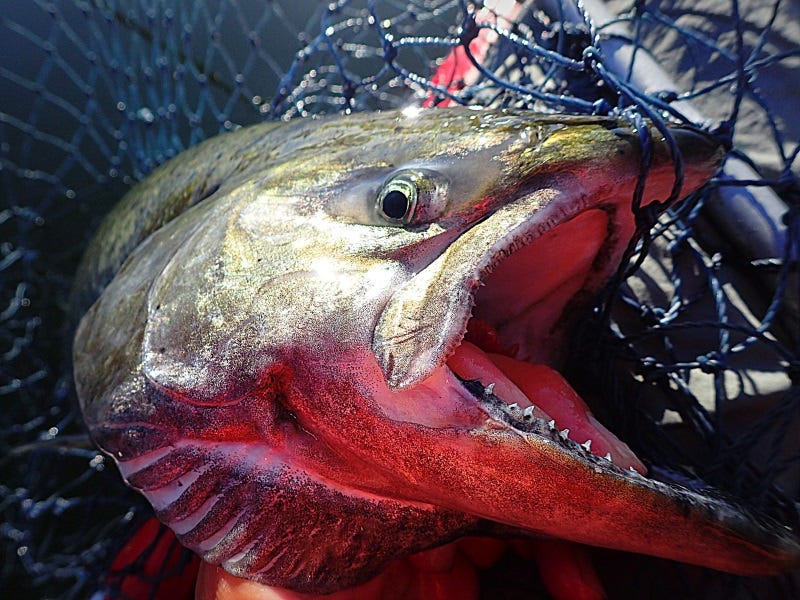Dropper Rigs for Salmon: When Precision is Your Enemy


As I slowly turned my boat the inside rod exploded into life, with the deep throbs and drag-screaming runs that tells an angler one thing: Chinook salmon on the line. A few minutes later I boated a beautiful 18-pound hatchery king that would soon migrate to my freezer. It is no coincidence that the bite came on the turn as, over the years, I've bagged many salmon "on the drop.” Unlike the boats now fishing all around me, I was not running downriggers.
Check out our terminal tackle, fishing line, and our selection of fishing rods.
I cut my teeth on lower Columbia River salmon fisheries where strong currents, snags, and variable depths largely precluded the use of downriggers. The standard method in this reach of the river is a sliding cannonball rig placed 18-24 inches forward of your flasher, on a bumper of heavy monofilament. This does not dampen the motion of your attractor. Many anglers in snag-rich environments run the lead cannonball on a 1 to 3-foot segment of weak monofilament. If the lead snags it will break away and an angler still has the rest of their rigging. The slider is followed by a bead to protect your knot, followed by a six-bead chain that allows the flasher or dodger to rotate without twisting the line. From there you run your rig as you would when fishing with a downrigger. I've since applied this method to other salmon fisheries in the Columbia’s upriver impoundments, and even for landlocked salmon fisheries, such as kokanee, with great success. While downriggers can and should remain a viable option in your king salmon efforts there are many compelling reasons to add a dropper rig off the back of the boat the next time you hit the water in pursuit of salmon. Here are some of those advantages:
COST
Let's face it, downriggers are an expensive investment costing many hundreds of dollars. Depending on how much lead you are running the average dropper rig will set you back $2-5 per rod.
SPACE EFFICIENT
I've spent most of my life fishing from small watercraft. I've just not had the space to squeeze a downrigger onto my boats. Dropper rigs and components can easily be carried in a small tackle box or coffee can.
BITE DETECTION
For small, light-biting salmon like sockeye or kokanee it can be easy to miss a bite on a downrigger setup. With the dropper rig there is a direct connection to the fish and there is no doubt when a fish comes knocking. Of course nothing beats the violent rod bending action of a king salmon slamming your lure on a dropper rig!
Bait harnesses and hardware are up online here.
COVER MORE WATER
Downriggers, when used in conjunction with quality electronics, can give you the confidence that you are putting gear right on the fish. However, if you do not have a fishfinder or fish are spread throughout the water column, droppers offer a distinct advantage over downriggers. As you speed the boat up or down or turn your boat while trolling, your gear rises and falls through the water column much more so than a downrigger setup allows. This allows you to cover more water efficiently.
ENTICING THE STRIKE
One of the most critical aspects of trolling for salmon is speed. Some days they like it faster; some days they prefer it slower. When making broad turns with a dropper rig the outside rod accelerates while the inside rod slows. I can’t count the number of times I've hooked fish on the turn. If I pick up more fish on the inside rod I know they are looking for a slower presentation. If the outside rod sees more action a little more speed might be called for on straight-line trolls.
STACK THE RODS IN YOUR FAVOR
By putting heavier weights on the rods fishing near the bow of the boat, and lighter weights towards the stern, you can easily run multiple rods at multiple depths with a dropper rig. When trolling for kings, coho, and sockeye in the Columbia, you may have to run 10 or 12 oz weights on the front rods, working back to as light as 6 or 8 oz on the rear rods. For early season kokanee I generally run ½ oz to 1 oz weights on the front rods with no weight on the rear rods. I’ll run up to 2 or 4 oz weights later in the season when the fish drop into deeper, cooler water in the summer months. These configurations allow you to spread gear across multiple depths with minimal risk of tangling.
Stop by neighborhood North 40 fishing department and let us help you get the drop on salmon before your next outing.

